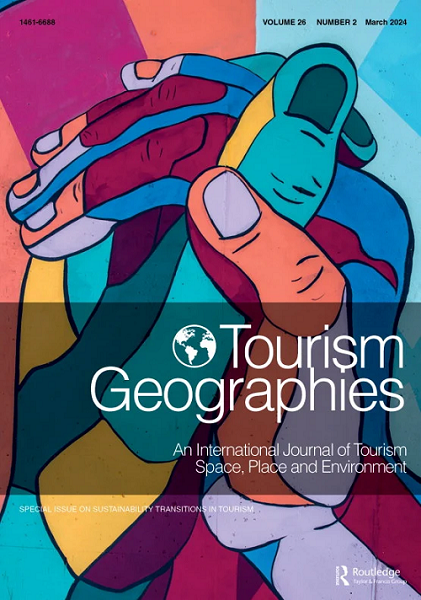Fake news simulated performance: gazing and performing to reinforce negative destination stereotypes
IF 4.1
3区 管理学
Q1 HOSPITALITY, LEISURE, SPORT & TOURISM
引用次数: 0
Abstract
AbstractDestinations with populations of African descent have continuously experienced negative stereotypes portrayed in traditional Western print media. These narratives have expanded to fake news circulating among individuals online, which calls for new techniques in combatting this issue. As there is limited evidence related to fake news in destinations, this research examines how fake news has emerged as a means of reinforcing negative stereotypes for destinations by examining three cases. It proposes a geographical perspective for understanding the production of fake news in tourism as simulated performances incorporating the setting of the frontstage, gazers and changing identities. These aspects drive the visibility, legitimacy and resistance to fake news, which can affect economic gains and conflicting discourses regarding these destinations. This research moves away from conceptualising fake news as solely narratives, as has been done previously. As a result, it draws attention to the spatiality of the phenomenon, which can provide practitioners with insights for developing and implementing destination image repair strategies. Practitioners should incorporate gazers into their strategies for combatting stereotypes. They also need to carry out continuous and real-time repair alongside bunking strategies prior to and during performances. Debunking strategies should provide contextual data in order to be effective. Alongside the empirical contributions, the research enhances the theoretical underpinning of fake news, social media and generally technologies in tourism through the application of concepts within media and black geographies research. These research areas remain understudied in tourism but can serve as pathways to guide further analyses on race in online contexts.Keywords: Black geographiesdestination imagefake newsgazemedia geographiesperformancesocial media Disclosure statementNo potential conflict of interest was reported by the author(s).Additional informationNotes on contributorsAbbie-Gayle JohnsonAbbie-Gayle Johnson is an assistant professor at the School of Hotel and Tourism Management at The Hong Kong Polytechnic University. Her research interests include destination marketing, smart tourism and the sharing economy.假新闻模拟表演:凝视和表演来强化负面的目的地刻板印象
【摘要】非洲裔目的地在传统的西方平面媒体中一直受到负面刻板印象的影响。这些叙述已经扩大到在网上个人之间传播的假新闻,这需要新的技术来解决这个问题。由于与目的地假新闻有关的证据有限,本研究通过三个案例来研究假新闻是如何成为强化目的地负面刻板印象的手段的。它提出了一个地理角度来理解假新闻在旅游中的生产,作为模拟表演,包括舞台前的设置,凝视者和不断变化的身份。这些方面推动了假新闻的可见性、合法性和抵抗力,这可能会影响这些目的地的经济收益和相互冲突的话语。这项研究不再像以前那样,将假新闻概念化为纯粹的叙述。因此,它引起了对这一现象的空间性的关注,这可以为从业者提供制定和实施目的地图像修复策略的见解。从业者应该将凝视者纳入他们对抗刻板印象的策略中。他们还需要在作业前和作业期间进行连续和实时的维修,同时还需要采取掩体策略。揭穿策略应该提供上下文数据,这样才能有效。除了实证贡献外,该研究还通过应用媒体和黑色地理学研究中的概念,加强了假新闻、社交媒体和一般技术在旅游业中的理论基础。这些研究领域在旅游业中仍未得到充分研究,但可以作为指导在线背景下进一步分析种族的途径。关键词:黑人地理目的地图像造假新闻媒体地理表现社交媒体披露声明作者未报告潜在的利益冲突。作者简介:abbie - gayle Johnson,香港理工大学酒店及旅游管理学院助理教授。她的研究兴趣包括目的地营销、智能旅游和共享经济。
本文章由计算机程序翻译,如有差异,请以英文原文为准。
求助全文
约1分钟内获得全文
求助全文
来源期刊

Tourism Geographies
HOSPITALITY, LEISURE, SPORT & TOURISM-
CiteScore
25.90
自引率
3.10%
发文量
19
期刊介绍:
Tourism Geographies is a peer-reviewed journal that focuses on exploring tourism and its related areas of recreation and leisure studies from a geographic perspective. It brings together academic and applied research as well as regional traditions from across the globe. The journal welcomes multidisciplinary approaches from fields such as geography, anthropology, landscape architecture, urban and regional planning, and environmental science and management. Tourism Geographies publishes various types of content including research articles, review articles, commentaries, literature reviews, and news related to affiliated organizations. All research articles and commentaries in the journal undergo a rigorous peer review process, including editor screening and double-anonymized evaluation conducted by two to three anonymous referees.
 求助内容:
求助内容: 应助结果提醒方式:
应助结果提醒方式:


